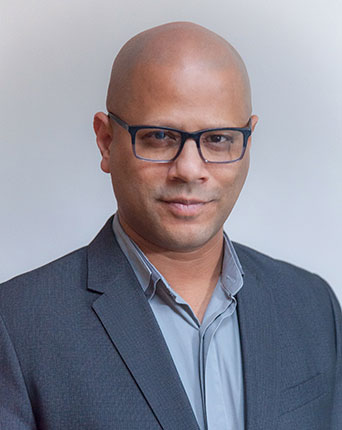
Hasan Elahi, Director of Mason's School of Art
The College of Visual Art is honored to welcome Hasan Elahi as the new director for Mason’s School of Art. The accomplished interdisciplinary media artist first visited Mason seven years ago as part of the Visual Voices program, and much has changed since then. He says, “I’ve had the privilege of speaking at over a hundred universities as a visiting artist, and I can confidently attest that very few places are as dynamic and quickly evolving as Mason and the School of Art.” He is interested in how the School of Art can be a national leader for a new and rapidly changing creative economy and be a major catalyst for the arts to play a more integral role in the university and society as a whole.
As an artist, Elahi’s body of work examines issues of surveillance, citizenship, migration, transport, and the challenges of borders and frontiers. His work has been presented in numerous international exhibitions and has been covered by The New York Times, Forbes, Wired, and more. His recent awards include a Guggenheim Fellowship, an Alpert/MacDowell Fellowship, grants from Creative Capital, Art Matters Foundation, the Doris Duke Foundation for Islamic Art, and he is a recipient of a Hugh M. Hefner First Amendment Award. Currently, he is a Professor and the new Director of the School of Art at George Mason University.
His best-known work is Tracking Transience, a self-surveillance project that continuously and publicly presents his exact location, activities, and personal data. The attention-grabbing project was born out of a harrowing post 9-11 experience, where Elahi was erroneously reported to the FBI as a terrorist. He spent six months working to clear his name and reputation through repeated interrogations and lie detector tests. After that, he decided to alert the FBI on his whereabouts and activities, and then open up all that information to the public. The work has evolved over the years into a myriad of multidisciplinary directions. Sometimes Tracking Transience is shown as a video, sometimes as a live data feed, sometimes as wall-sized photographs and large sculptural installations. No matter the format, the theme of the work—as a critique of contemporary culture and investigative techniques that make it necessary to provide an ongoing “alibi”—remains timely, even if self-surveillance via “social media” is now an ever-present part of our current cultural milieu.
Lately, Elahi has been working on a new body of work that investigates the relationship between landscape and surveillance. He explains, “I’ve been recreating historic American landscape paintings from the 19th century, using modern-day consumer technologies that have grown out of military developments. It is important for me that the paintings selected for these works were all created during a time as the depicted territory was becoming a part of the US. Often these paintings were commissioned to take inventory of the natural resources of the country at a time as we were growing into a world power. The works are very much about the location and the then and now aspect of the land, but also raises serious questions about what the genre of landscape means in a political context today.”
The depiction of territory and the specificity of location are significant themes in Elahi’s work—whether they be of the grandeur of some western landscape of the banality of the interior of a nondescript office building. The photos in Tracking Transience are timestamps of specific locations in a long timeline spanning nearly two decades. Most of these images could be anywhere and everywhere to the general viewer, but if the viewer knows the location and has an experience with that very same location depicted, it can only be that one specific place and nowhere else. Another example of this occurs in An Undisclosed Location (2012), which at first look like a collection of generic real estate photos, however, they are photographs of paintings of photographs taken inside Dick Cheney’s house in St Michaels. Anyone that has been inside that house knows that those images can only be of that particular house and nowhere else.
As far as Elahi’s artistic process, he generally starts with an idea that he’s interested in and then find the most appropriate media or tool for it. Sometimes the process is clearly defined at the start of the project. For example, in An Undisclosed Location, he knew he wanted photographs of paintings and not the paintings nor the original photographs themselves as that intermediate step of painting the image adds a level of ambiguity to the documentary nature of the photograph. “Other times,” he explains, “as in Airstrip One, the idea might be best presented as a slab of marble that gets carved by a router to create airport landing diagrams since the space that it was shown in needed that kind of material."
When he is not in his studio, Elahi can be found at 38.830217000, -77.307591000, Mason’s School of Art, supporting faculty research, increasing interdisciplinary initiatives and opportunities for students and faculty, and growing the visibility for all the fantastic things that are already happening at Mason.
